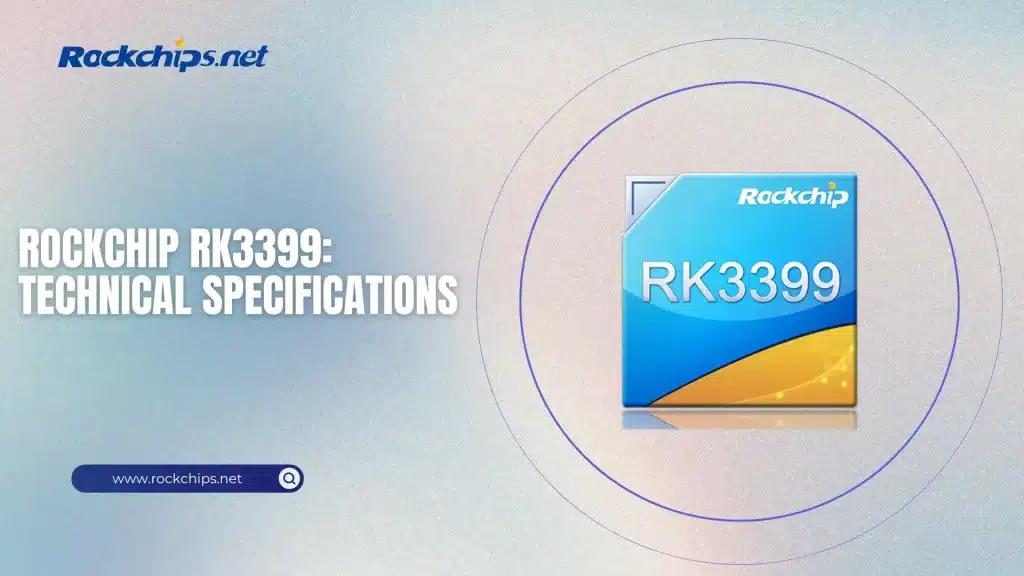
The Rockchip RK3399 is a system-on-chip (SoC) designed for embedded systems and mobile computing applications. As part of Rockchip’s processor lineup, the RK3399 implements an ARM big.LITTLE architecture combining Cortex-A72 and Cortex-A53 CPU cores with a Mali-T864 GPU. This hexa-core processor targets devices requiring balanced performance and power efficiency, including single-board computers and multimedia systems.
The RK3399 is fabricated using a 28nm HKMG process technology, which provides a balance between performance and power efficiency. The SoC’s thermal design power (TDP) typically ranges from 2W to 8W depending on workload, making it suitable for both fanless designs and actively cooled systems. The processor supports multiple operating systems including Android, Linux distributions (Debian, Ubuntu, etc.), and other embedded RTOS solutions.
Architecture and Processor Design
The RK3399 utilizes a heterogeneous computing architecture that allocates workloads between different processor core types based on performance requirements.
CPU Core Configuration
The processor contains two CPU clusters:
- Dual-core ARM Cortex-A72 (up to 2.0GHz)
- Quad-core ARM Cortex-A53 (up to 1.5GHz)
This configuration allows the operating system to schedule tasks on appropriate cores depending on computational demands.
Memory Architecture
The memory controller supports:
- DDR3/DDR3L at 1866MHz
- LPDDR3 at 1866MHz
- LPDDR4 at 1600MHz
The dual-channel implementation provides sufficient bandwidth for most embedded applications.
NEON Processing Capabilities
The dedicated NEON coprocessor accelerates vector operations for:
- Media processing workloads
- Signal processing algorithms
- General-purpose floating-point operations
Graphics and Video Processing
The RK3399 includes several hardware blocks for graphics and video processing tasks.
GPU Specifications
The Mali-T864 GPU provides support for:
- OpenGL ES 1.1/2.0/3.0/3.1
- OpenCL 1.2
- DirectX 11.1
The GPU operates at frequencies up to 800MHz depending on thermal conditions and power constraints.
Video Codec Support
The video processing unit handles:
- Decoding: H.264/H.265/VP9 up to 4K@60fps
- Encoding: H.264/MVC/VP8 at 1080p@30fps
- JPEG encode/decode operations
Performance Characteristics and Benchmarks
The following table compares RK3399 performance with similar ARM-based SoCs:
| Feature | RK3399 | RK3288 | Amlogic S912 |
|---|---|---|---|
| CPU Cores | 2x A72 + 4x A53 | 4x A17 | 4x A53 + 2x A72 |
| GPU | Mali-T864 | Mali-T760 | Mali-T820 |
| Memory Interface | Dual-channel | Dual-channel | Single-channel |
| 4K Video Support | Yes | Yes | Yes |
Power Consumption
Typical power characteristics:
- Idle power: ~0.5W
- Average load: 2-5W
- Peak power: Up to 8W
Thermal Performance
The SoC operates within standard temperature ranges:
- Commercial grade: 0°C to 70°C
- Industrial grade: -40°C to 85°C (optional)
Conclusion
The Rockchip RK3399 represents a well-balanced system-on-chip solution that continues to find relevance in embedded applications years after its introduction. Its ARM big.LITTLE architecture, combining Cortex-A72 and Cortex-A53 cores, delivers a practical compromise between computational performance (achieving 13,500 DMIPS at 2.0GHz) and power efficiency (scaling down to 0.5W in idle states). The Mali-T864 GPU, while not cutting-edge by current standards, provides adequate graphics performance for most embedded GUI applications and light gaming workloads, with support for modern APIs including OpenGL ES 3.2 and Vulkan 1.0.
From a system design perspective, the RK3399’s comprehensive peripheral set – including dual USB 3.0 ports, PCIe 2.1, and multiple display interfaces – enables flexible product implementations without requiring extensive external bridging chips. The processor’s video processing capabilities remain particularly noteworthy, with its dedicated VPU supporting 4K60 H.265/H.264/VP9 decoding and 1080p60 encoding, making it suitable for media-centric applications even in 2024.
Several technical factors contribute to the RK3399’s continued market presence:
- Thermal Design Flexibility: The 28nm HKMG process allows implementations ranging from fanless designs (3-5W TDP) to actively cooled performance configurations (up to 8W)
- Memory System Efficiency: The dual-channel memory controller maintains sufficient bandwidth (14.9GB/s theoretical maximum) for most embedded workloads while supporting cost-effective memory technologies
- Software Maturity: Extensive Linux mainline support and Android compatibility reduce development risks compared to newer, less-proven SoCs
- Cost-Effectiveness: As a mature platform, the RK3399 offers favorable BOM costs for mid-range embedded applications
While surpassed by newer processors in raw performance (such as the RK3588 or Amlogic A311D), the RK3399 maintains relevance in applications where its balanced performance, proven reliability, and comprehensive I/O capabilities align with project requirements. Its continued use in industrial control systems, digital signage, and educational devices demonstrates the enduring value of this SoC architecture. For developers requiring a stable platform with extensive documentation and community support, the RK3399 remains a viable choice among mid-range ARM processors, particularly for Linux-based embedded systems where predictable performance and thermal characteristics are prioritized over cutting-edge specifications.
Future applications will likely continue leveraging the RK3399’s strengths in:
- Legacy system upgrades where pin compatibility matters
- Cost-sensitive 4K media applications
- Industrial applications requiring long-term availability
- Educational platforms benefiting from mature toolchains